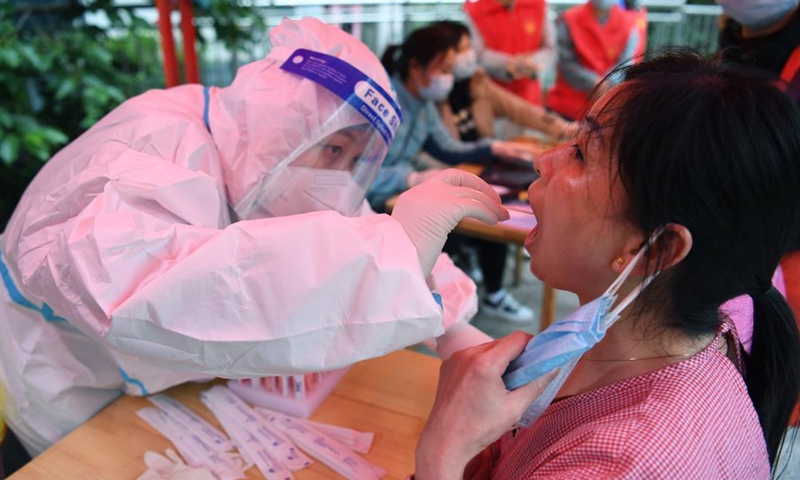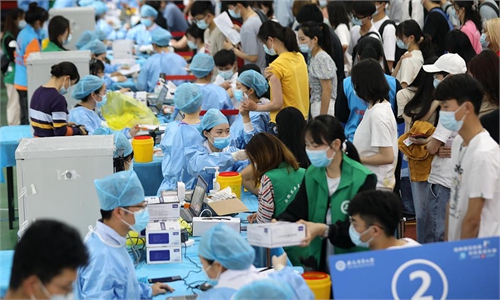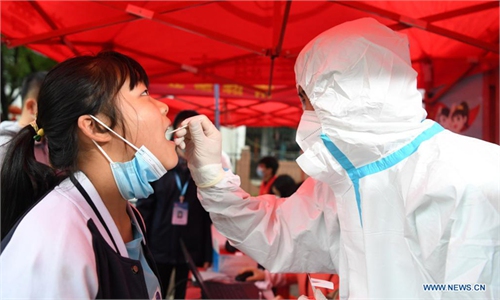Why can China confine flare-ups to dozens cases?
Quick tests, epidemiological research prevent virus spread, mutation and scale down outbreaks

A medical worker collects a swab sample from a resident for nucleic acid testing at a community in Shangpai Township of Feixi County, east China' Anhui Province, May 16, 2021. East China's Anhui Province on Saturday reported no new confirmed, suspected or asymptomatic COVID-19 cases, the provincial health commission said Sunday.(Photo:Xinhua)
One and a half years after human beings identified the SARS-CoV-2, a majority of the world is still struggling with infected cases, and some countries and regions once exemplary in handling the COVID-19 are facing the risk of being devoured by virus variants. This prompted a question: Why can China withstand more than 10 rounds of domestic resurgences, and reduce the scale of outbreaks from the Xinfadi outbreak that involved hundreds in Beijing to the latest infections of dozens in East China's Anhui and Northeast China's Liaoning provinces?
Infections were limited to 16 patients and 13 silent carriers as of Tuesday, which demonstrated how massive testing, epidemiological investigations and strict quarantines of close contacts have become more efficient through practices in each round of resurgence, while experts also attributed the achievements to public awareness, nonexistence of domestic virus plus tight port controls, which restricted virus spread and mutations.
The infections in Liaoning and Anhui were discovered from a patient reported on Thursday. The infection chain became clear the following day and the possibility of highly contagious strains first discovered in India and South Africa were ruled out. At least two rounds of massive nucleic acid tests were carried out, while communities with transmission risks were locked down.
In four days, new cases were found only among people under quarantine, and officials have announced that the risk of further spread is low.
Yang Zhanqiu, deputy director of the pathogen biology department at Wuhan University, told the Global Times on Tuesday that "China adopted 'an entire army' to wipe a virus flare-up out. Prompt and decisive response means the virus would always be nipped in the bud."
After the hard-won battle in early 2020, China has basically eliminated the domestic existence of the virus, experts said.
For countries like India and the US that have never eliminated the virus, the virus strains keep spreading and mutating among patients. Though the daily infection tolls might stay low for a while, the epidemic control fruits could suffer a blow with any relaxation or changes in temperature, not to mention looming threats of new virus variants, Yang said.
Singapore, which was once hailed by media as "the world's best place to be," reported 21 new domestic cases on Monday. After more than a month without detecting new community transmissions, Vietnam recorded about 1,200 cases in the past three weeks. Indian variants were confirmed in those two countries, media reports said.
The island of Taiwan, once a self-claimed "excellent student" in epidemic control for killing inland virus, found the illusion torn apart when imported cases started community transmissions, exposing the island's loophole in testing and close contact tracing.
The tight control, strict quarantine and testing at port cities also build up a strong wall that protected China from many dangerous variants. The Indian variants have been found in China among international arrivals but not in domestic flare-ups. Yang raised the possibility of lower infectivity and virulence of strains found in those resurgences, but no data could be found to support this assumption.
Experience from practices
Since the initial outbreak in early 2020, China has withstood the test of about 10 rounds of regional outbreaks as well as large-scale population mobility during vacations, including the National Day golden week in 2020, the Spring Festival and the May Day holidays in 2021.
The first major outbreak since the COVID-19 was mostly curbed in two months in early 2020 was the one connected to Beijing's Xinfadi seafood market. Despite the capital city's stronger testing and epidemiological investigation capability than other places, the outbreak ultimately involved 335 patients and lasted almost a month before the last confirmed patient was reported on July 5.
In contrast, a late flare-up in Beijing's Shunyi district at the yearend was dealt in a much quicker and more effective manner in terms of massive testing, epidemiological research, indentifying close contacts and analyzing the virus trace. The outbreak ended with infections of dozens and was mostly under control in less than three weeks.
The remote Northwest China's Xinjiang Uygur Autonomous Region also saw two large-scale outbreaks in July and October, respectively. The region acquired the capacity of massive testing to screen out patients and silent carriers from the first resurgence, which helped curb the second round quickly.
Liaoning, together with Heilongjiang, another Northeast China province, experienced a major outbreak in late 2020. The two provinces spent three weeks from discovering the first case to zero daily new cases, and the outbreak involved hundreds.
At that time, local governments in some cities appeared unprepared for massive testing and community lockdowns, and the epidemiological investigations were slow. But this time, Liaoning, as well as Anhui that found patients on the same infection chain, appeared more experienced in responding to the emergency.
In March, border city Ruili in Southwest China's Yunnan Province withheld the great pressure of imported cases and a resurgence was restricted to dozens of cases. In addition to routine methods of testing and quarantine, the city administered COVID-19 vaccines to its 300,000 residents in a week.
The Global Times found a trend of faster nucleic acid testing and epidemiological investigations, more effective decisive control measures, and a reduced outbreak scale of previous sporadic outbreaks.
Zeng Guang, former chief epidemiologist of the Chinese Center for Disease Control and Prevention, told the Global Times on Tuesday China has shaped its own anti-epidemic strategy: Not simply treat infected patients but cut off the disease infection routes by screening out and quarantining every close contact or potential virus carrier through prompt epidemiological investigations.
The strategy is possible based on previous successes of clearing domestic cases and ruling out the virus, plus effective screening.
Experts also noted China's extensive landscape and huge population is a challenge to epidemic control, as flare-ups will always occur when the world is not free of the coronavirus. But it also means rich national resources to tackle sporadic "fires" and opportunities to learn from other cities and regions' experiences.
"The strategy also relies on laws and efforts of every Chinese resident," Zeng said.
China's law on the prevention and control of infectious diseases allows authorities not only to quarantine confirmed cases but to quarantine close contacts without symptoms and silent virus carriers who are also contagious, before they become new infection sources, Zeng explained.
Apart from a response scheme rolled out by local officials, the country's National Health Commission and the newly established national administration of disease prevention and control dispatched expert teams to Anhui and some to Liaoning to help with local epidemic resurgence.
Another mechanism contributed to China's success is holding local officials in charge of epidemic control accountable. China removed at least five officials and issued warnings to dozens of other officials for their dereliction of duty amid the Anhui and Liaoning resurgence.
China is so far the country that has held the largest numbers of officials accountable for failing to properly tackle the epidemic worldwide.
Zheng Zhijie, a professor and chair of the department of global health at Peking University, told the Global Times Tuesday that wearing a facial mask in public and keeping social distance are open secrets for China to control epidemic flare-ups.
Though the public has gradually loosened many measures, they would pick up the habit whenever there is an emergency as such awareness has been firmly established during previous resurgences, experts said.
Always prepared
While China is able to contain the rapid spread of the virus in a short period of time and ensure that economic and social development is minimally affected, sporadic cases will continue to emerge since no country is safe before the entire world is safe, observers said.
Domestic outbreaks have been found to be connected to imported items or people returning from abroad, meaning China's gate should continue to be guarded and vaccination pace shall be accelerated, they said.
The latest flare-ups already drove local residents in Anhui and Liaoning to show high enthusiasm in vaccination and the country has been making records on daily doses being administered over the past few days. China administered a record of 15 million doses of COVID-19 vaccines on Monday and some 422 million doses in total have been administered domestically.
Zeng noted that China deserves the title of "exemplary country in epidemic control," and the system of prevention, discovery and response serves as a reference for the world, through which China accumulated experience and enhanced confidence in dealing with potential future global public health crises.



